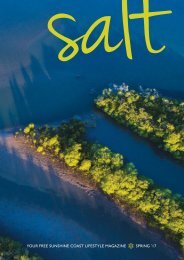LakeAnna 2017/2018
- No tags were found...
You also want an ePaper? Increase the reach of your titles
YUMPU automatically turns print PDFs into web optimized ePapers that Google loves.
feature|angler’s paradise<br />
Fishing Continued From Page 33<br />
Now we are moving into summer patterns.<br />
The fish will start to pull out of the shallows<br />
and move out with the increasing boat traffic<br />
and warmer water temperatures. Deeper<br />
brush piles, rock piles, boat docks and bridge<br />
pilings will all hold numbers of fish in the<br />
summertime. (Baits of choice include deep<br />
diving crankbaits, large Texas rigged worms,<br />
shaky head worms and jig and pig combos.) I<br />
have caught fish as deep as 35 feet, but most<br />
will stay in the 15’–25’ range.<br />
They will stay in these areas all summer<br />
long until the water temperature starts to drop<br />
back off in the fall—usually by mid-October<br />
they are shallow again, as this is the beginning<br />
of the fall feeding frenzy. Look for shad and<br />
blueback herring in the backs of creeks actively<br />
chasing bait balls all day long. Small crankbaits,<br />
spinnerbaits, lipless crankbaits, hard jerkbaits and<br />
soft jerkbaits are all great bait fish imitators and<br />
will catch fish for you.<br />
As the winter months close in, those anglers<br />
brave enough to outlast the elements can be<br />
rewarded with giant bass and heavy bags to<br />
bring onto the scales. Vertical jigging is one of<br />
the best ways to catch them at this time of year.<br />
Learning your electronic devices is a must for<br />
this type of fishing.<br />
CRAPPIE<br />
The Black Crappie, also known as specks,<br />
freckles and silver perch, comes in a close<br />
second to the Largemouth Bass for Lake Anna<br />
anglers. These tasty panfish are hearty fighters<br />
and plentiful throughout Lake Anna—though<br />
up lake has better fishing than down lake. There<br />
are many trophy-sized crappie in Lake Anna,<br />
but they are the exception and not the rule. For<br />
a crappie to be considered a trophy in Virginia,<br />
they must be either 2 pounds or 15 inches. We<br />
weigh in several every year at Fish Tales, fishing<br />
and boating headquarters located in Mineral, for<br />
our customers. Though there is no minimum<br />
size on crappie in Lake Anna, there is a 25 fish<br />
per day, per angler creel limit. Personally, I try<br />
not to keep any fish less than 10 inches.<br />
Once March rolls around, the crappie start<br />
making their move toward the shallows; usually<br />
they are the first fish to spawn in the spring.<br />
They will start staging around spawning areas<br />
waiting on water temperatures to get right (60–<br />
66 degrees). Although I have seen them spawn<br />
in temperatures as low as 56 degrees.<br />
The males are the first ones to pull up and<br />
start the spawning ritual; several males will pull<br />
into one area and do their dance to attract<br />
females. Their spawn is much different than a<br />
bass; it is not just one male and one female. As<br />
the spawn draws closer, the males will turn<br />
a dark black and purple hue; we call this<br />
“full tuxedo.” Sometimes they will be almost<br />
pitch black.<br />
Crappies are very aggressive throughout the<br />
spawn and will take a variety of artificial baits<br />
and colors as well as minnows. Many anglers<br />
use small minnows rigged under a slip bobber<br />
to catch them; I, on the other hand, prefer to<br />
employ 2-inch curly tail grubs rigged on a<br />
one-sixteenth ounce jig head. If you find that<br />
you are catching numbers of smaller males, all<br />
you need to do is back off a little deeper for the<br />
females; the girls are not far behind.<br />
They spawn in many types of cover, such<br />
as willow grass, beaver huts, lay down trees,<br />
rocks and boat docks. I have even caught them<br />
spawning on sea walls and in water from just<br />
a foot to about six feet deep down. The spawn<br />
will usually last about six weeks, with the first<br />
three weeks being the best. The large mature<br />
fish will spawn first, followed by the smaller,<br />
immature fish.<br />
After the spawn is over in mid-May, they<br />
will start retreating back to deeper water for the<br />
summer months; I usually leave them alone for this<br />
period of time. You have to catch and go through<br />
lots of small fish, just to catch a few keepers.<br />
During summer, they’re in deep boat docks,<br />
deep bridge pilings, deep rock piles and some<br />
will just suspend over deep water. Did you<br />
notice the common denominator for the<br />
summertime? Deep! The most popular place to<br />
catch them during the summer is around the<br />
many bridge pilings throughout the lake. They<br />
can be anywhere from 10 feet all the way down<br />
to 30 feet; a small minnow on a one-sixteenth<br />
or one-eighth-ounce jighead will produce the<br />
best results.<br />
The most important part of crappie fishing<br />
is the rod, reel and line. To thoroughly enjoy<br />
crappie fishing, a lite or ultra lite rod is a must.<br />
These fish are very hard fighters for pan fish;<br />
if you have too large of a rod, it is really no<br />
fun at all. A 6-pound test line is really about as<br />
heavy as you will want to use; I use a 4-pound<br />
test line about 90 percent of the time. The best<br />
part about crappie fishing is that these are great<br />
angling fish for kids—once you find them, the<br />
action can last for hours in just one spot!<br />
As summer ends and fall begins, they will start<br />
to follow bait balls into the creeks, and they will<br />
set up an ambush around the many boat docks.<br />
A little more skill is involved in fall crappie<br />
fishing; they will set up as far as they can under<br />
boat docks, and skipping or shooting your grub<br />
is a must. If the water level in the lake is down<br />
about a foot, it makes it much easier to get your<br />
bait to the fish. Small minnows will also work;<br />
just keep in mind that most of the fish are under<br />
the docks so you will have to be very patient<br />
and wait for them to come out to you.<br />
Fall is now over and wintertime is setting in;<br />
the water temperature is now in the low forties;<br />
and the fish have pulled out of the shallows.<br />
Some fish will relocate to deep brush piles and<br />
34 LAKE ANNA GUIDE | <strong>2017</strong>/<strong>2018</strong>






